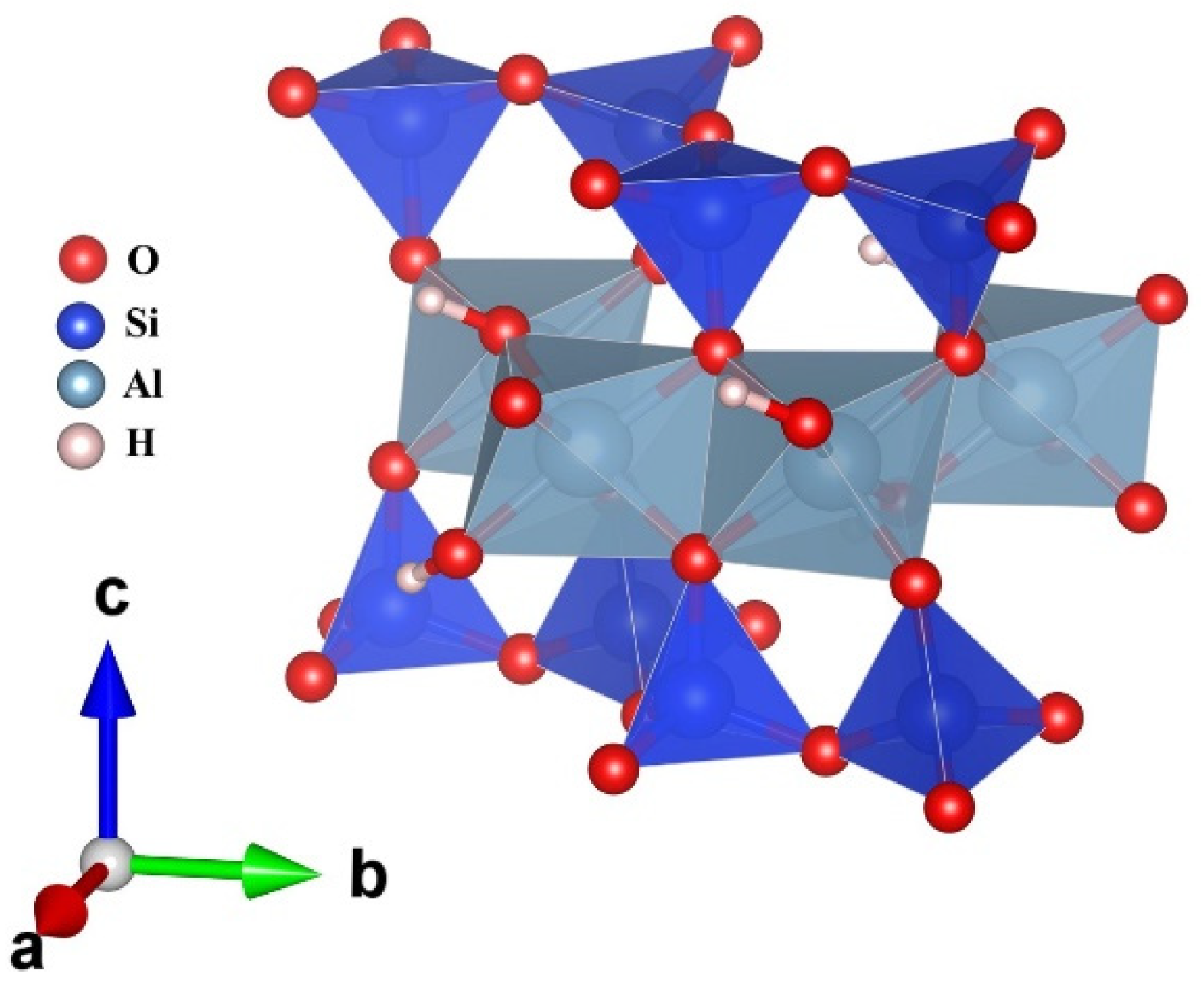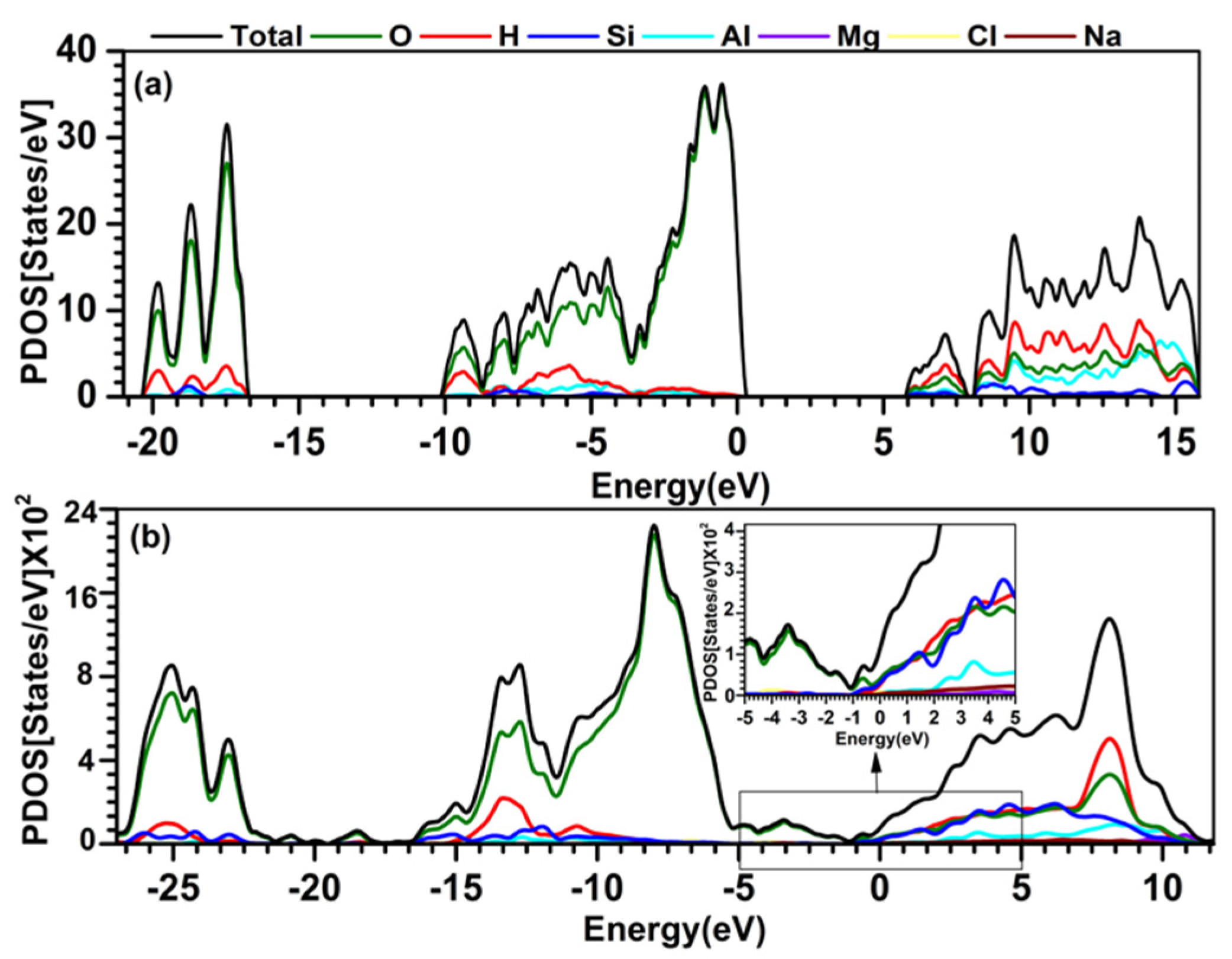Electronic Structure and Mechanical Properties of Solvated Montmorillonite Clay Using Large-Scale DFT Method
Abstract
1. Introduction
2. Model Construction
3. Methods
4. Results and Discussion
4.1. Electronic Structure and Interatomic Bonding
4.2. Mechanical Properties
5. Conclusions
Author Contributions
Funding
Institutional Review Board Statement
Informed Consent Statement
Data Availability Statement
Acknowledgments
Conflicts of Interest
References
- Murray, H.H. Overview—Clay mineral applications. Appl. Clay Sci. 1991, 5, 379–395. [Google Scholar] [CrossRef]
- Sarkar, B.; Rusmin, R.; Ugochukwu, U.C.; Mukhopadhyay, R.; Manjaiah, K.M. Modified clay minerals for environmental applications. In Modified Clay and Zeolite Nanocomposite Materials; Elsevier: Amsterdam, The Netherlands, 2019; pp. 113–127. [Google Scholar]
- Keith, K.; Murray, H. Clay liners and barriers; Society for Mining, Metallurgy and Exploration: Littleton, CO, USA, 1994; pp. 249–255. [Google Scholar]
- Giovannini, G.; Garoli, D.; Rupper, P.; Neels, A.; Rossi, R.M.; Boesel, L.F. Metal-modified montmorillonite as plasmonic microstructure for direct protein detection. Sensors 2021, 21, 2655. [Google Scholar] [CrossRef] [PubMed]
- Kumari, N.; Mohan, C. Basics of Clay Minerals and Their Characteristic Properties; IntechOpen: London, UK, 2021; Volume 24, pp. 1–29. [Google Scholar]
- Huggett, J. Glauconites. In Encyclopedia of Geology; Selley, R.C., Cocks, L.R.M., Plimer, I.R., Eds.; Elsevier: Oxford, UK, 2005; pp. 542–548. [Google Scholar]
- Brindley, G.W. CLAYS, CLAY MINERALSClays, clay minerals. In Mineralogy; Springer: Boston, MA, USA, 1983; pp. 69–80. [Google Scholar]
- Essington, M.E. Soil and Water Chemistry: An Integrative Approach; CRC Press: Boca Raton, FL, USA, 2015. [Google Scholar]
- Sparks, D.L. Kinetics of ionic reactions in clay minerals and soils. Adv. Agron. 1986, 38, 231–266. [Google Scholar]
- Young, D. Computational Chemistry: A Practical Guide for Applying Techniques to Real World Problems; John Wiley & Sons: Hoboken, NJ, USA, 2004. [Google Scholar]
- Parr, R.G. Density functional theory of atoms and molecules. In Horizons of Quantum Chemistry; Springer: Berlin/Heidelberg, Germany, 1980; pp. 5–15. [Google Scholar]
- Lee, Y.-K. Density Functional Theory (DFT) Calculations and Catalysis. Catalysts 2021, 11, 454. [Google Scholar] [CrossRef]
- Lorenz, P.; Meier, L.; Kahr, G. Determination of the cation exchange capacity (CEC) of clay minerals using the complexes of copper (II) ion with triethylenetetramine and tetraethylenepentamine. Clays Clay Miner. 1999, 47, 386–388. [Google Scholar]
- Marchuk, S.; Rengasamy, P.; Churchman, J. Cation exchange as influenced by the type of cations in different clay minerals. In Proceedings of the Australian Regolith and Clays Conference, Mildura, Australia, 7–10 February 2012. [Google Scholar]
- Fernandes, M.M.; Baeyens, B. Cation exchange and surface complexation of lead on montmorillonite and illite including competitive adsorption effects. Appl. Geochem. 2019, 100, 190–202. [Google Scholar] [CrossRef]
- Luckham, P.F.; Rossi, S. The colloidal and rheological properties of bentonite suspensions. Adv. Colloid Interface Sci. 1999, 82, 43–92. [Google Scholar] [CrossRef]
- Al-saeedi, A.A. Clay basics and their physical and chemical properties. Iaetsd J. Adv. Res. Appl. Sci. 2022, 10, 13–18. [Google Scholar]
- Hartwell, J. The diverse uses of montmorillonite. Clay Miner. 1965, 6, 111–118. [Google Scholar] [CrossRef]
- Toth, R.; Voorn, D.-J.; Handgraaf, J.-W.; Fraaije, J.G.; Fermeglia, M.; Pricl, S.; Posocco, P. Multiscale computer simulation studies of water-based montmorillonite/poly (ethylene oxide) nanocomposites. Macromolecules 2009, 42, 8260–8270. [Google Scholar] [CrossRef]
- Katti, D.R.; Ghosh, P.; Schmidt, S.; Katti, K.S. Mechanical properties of the sodium montmorillonite interlayer intercalated with amino acids. Biomacromolecules 2005, 6, 3276–3282. [Google Scholar] [CrossRef] [PubMed]
- Honorio, T.; Brochard, L.; Vandamme, M. Hydration phase diagram of clay particles from molecular simulations. Langmuir 2017, 33, 12766–12776. [Google Scholar] [CrossRef]
- Teich-McGoldrick, S.L.; Greathouse, J.A.; Jove-Colon, C.F.; Cygan, R.T. Swelling properties of montmorillonite and beidellite clay minerals from molecular simulation: Comparison of temperature, interlayer cation, and charge location effects. J. Phys. Chem. C 2015, 119, 20880–20891. [Google Scholar] [CrossRef]
- Takata, M.; Tomozawa, M.; Watson, E. Effect of Water Content on Transport in Na2O·3SiO2 Glass. J. Am. Ceram. Soc. 1982, 65, 91–93. [Google Scholar] [CrossRef]
- Ching, W. Theoretical studies of the electronic properties of ceramic materials. J. Am. Ceram. Soc. 1990, 73, 3135–3160. [Google Scholar] [CrossRef]
- Feig, M.; Nawrocki, G.; Yu, I.; Wang, P.-h.; Sugita, Y. Challenges and opportunities in connecting simulations with experiments via molecular dynamics of cellular environments. J. Phys. Conf. Ser. 2018, 1036, 012010. [Google Scholar] [CrossRef]
- Subramanian, N.; Whittaker, M.L.; Ophus, C.; Lammers, L.N. Structural Implications of Interfacial Hydrogen Bonding in Hydrated Wyoming-Montmorillonite Clay. J. Phys. Chem. C 2020, 124, 8697–8705. [Google Scholar] [CrossRef]
- Caruba, R.; Baumer, A.; Ganteaume, M.; Iacconi, P. An experimental study of hydroxyl groups and water in synthetic and natural zircons: A model of the metamict state. Am. Mineral. 1985, 70, 1224–1231. [Google Scholar]
- Douillard, J.-M.; Lantenois, S.; Prelot, B.; Zajac, J.; Henry, M. Study of the influence of location of substitutions on the surface energy of dioctahedral smectites. J. Colloid Interface Sci. 2008, 325, 275–281. [Google Scholar] [CrossRef]
- Kresse, G.; Furthmüller, J. Vienna Ab-Initio Simulation Package (VASP); Vienna University: Vienna, Austria, 2001. [Google Scholar]
- Kresse, G.; Furthmüller, J. Efficient iterative schemes for ab initio total-energy calculations using a plane-wave basis set. Phys. Rev. B 1996, 54, 11169. [Google Scholar] [CrossRef]
- Sun, G.; Kürti, J.; Rajczy, P.; Kertesz, M.; Hafner, J.; Kresse, G. Performance of the Vienna ab initio simulation package (VASP) in chemical applications. J. Mol. Struct. THEOCHEM 2003, 624, 37–45. [Google Scholar] [CrossRef]
- Ching, W.-Y.; Rulis, P. Electronic Structure Methods for Complex Materials: The Orthogonalized Linear Combination of Atomic Orbitals; Oxford University Press: Oxford, UK, 2012. [Google Scholar]
- Kresse, G.; Joubert, D. From ultrasoft pseudopotentials to the projector augmented-wave method. Phys. Rev. B 1999, 59, 1758. [Google Scholar] [CrossRef]
- Perdew, J.P.; Burke, K.; Ernzerhof, M. Generalized gradient approximation made simple. Phys. Rev. Lett. 1996, 77, 3865. [Google Scholar] [CrossRef]
- Ching, W.-Y.; San, S.; Zhou, C.; Sakidja, R. Ab Initio Simulation of Structure and Properties in Ni-Based Superalloys: Haynes282 and Inconel740. Materials 2023, 16, 887. [Google Scholar] [CrossRef] [PubMed]
- Adhikari, P.; Jawad, B.; Rao, P.; Podgornik, R.; Ching, W.-Y. Delta variant with P681R critical mutation revealed by ultra-large atomic-scale ab initio simulation: Implications for the fundamentals of biomolecular interactions. Viruses 2022, 14, 465. [Google Scholar] [CrossRef] [PubMed]
- Khaoulaf, R.; Adhikari, P.; Harcharras, M.; Brouzi, K.; Ez-Zahraouy, H.; Ching, W.-Y. Atomic-scale understanding of structure and properties of complex pyrophosphate crystals by first-principles calculations. Appl. Sci. 2019, 9, 840. [Google Scholar] [CrossRef]
- Mulliken, R. Electronic population analysis on LCAO-MO molecular wave functions. J. Chem. Phys. 1955, 23, 1833–1840. [Google Scholar] [CrossRef]
- Mulliken, R. Overlap populations, bond orders and covalent bond energies. J. Chem. Phys 1955, 23, 1841–1846. [Google Scholar] [CrossRef]
- Nielsen, O.; Martin, R.M. First-principles calculation of stress. Phys. Rev. Lett. 1983, 50, 697. [Google Scholar] [CrossRef]
- Yao, H.; Ouyang, L.; Ching, W.Y. Ab initio calculation of elastic constants of ceramic crystals. J. Am. Ceram. Soc. 2007, 90, 3194–3204. [Google Scholar] [CrossRef]
- Reuß, A. Berechnung der fließgrenze von mischkristallen auf grund der plastizitätsbedingung für einkristalle. ZAMM-J. Appl. Math. Mech. Z. Für Angew. Math. Mech. 1929, 9, 49–58. [Google Scholar] [CrossRef]
- Hill, R. The elastic behaviour of a crystalline aggregate. Proc. Phys. Soc. Sect. A 1952, 65, 349. [Google Scholar] [CrossRef]
- Shafei, L.; Adhikari, P.; Ching, W.-Y. DFT Study of Electronic Structure and Optical Properties of Kaolinite, Muscovite, and Montmorillonite. Crystals 2021, 11, 618. [Google Scholar] [CrossRef]
- Zhang, Y.; Luo, Y.; Guo, X.; Xia, T.; Wang, T.; Jia, H.; Zhu, L. Charge mediated interaction of polystyrene nanoplastic (PSNP) with minerals in aqueous phase. Water Res. 2020, 178, 115861. [Google Scholar] [CrossRef] [PubMed]
- Pusch, R. Mechanical properties of clays and clay minerals. Dev. Clay Sci. 2006, 1, 247–260. [Google Scholar]
- Mhamdi, M.; Gasmi, N.; Elaloui, E.; Kbir-Ariguib, N.; Trabelsi-Ayadi, M. Study of the mechanical properties of clay containing smectite and carbonate. IOP Conf. Ser. Mater. Sci. Eng. 2010, 13, 012027. [Google Scholar] [CrossRef]
- Tian, Y.; Xu, B.; Zhao, Z. Microscopic theory of hardness and design of novel superhard crystals. Int. J. Refract. Met. Hard Mater. 2012, 33, 93–106. [Google Scholar] [CrossRef]
- Mavko, G.; Mukerji, T.; Dvorkin, J. The Rock Physics Handbook; Cambridge University Press: Cambridge, UK, 2020. [Google Scholar]
- Gaillac, R.; Pullumbi, P.; Coudert, F.-X. ELATE: An open-source online application for analysis and visualization of elastic tensors. J. Phys. Condens. Matter 2016, 28, 275201. [Google Scholar] [CrossRef]
- Škundrić, T.; Matović, B.; Zarubica, A.; Zagorac, J.; Tatarko, P.; Zagorac, D. Structure prediction and mechanical properties of silicon hexaboride on ab initio level. Materials 2021, 14, 7887. [Google Scholar] [CrossRef]
- Korabel’nikov, D.; Zhuravlev, Y.N. Ab initio investigations of the elastic properties of chlorates and perchlorates. Phys. Solid State 2016, 58, 1166–1171. [Google Scholar] [CrossRef]






| Model | K (GPa) | G (GPa) | E (GPa) | η | G/K | HV (GPa) |
|---|---|---|---|---|---|---|
| Cryst-MMT * | 31.85 | 23.74 | 57.05 | 0.2015 | 0.7453 | 6.201 |
| Solv-MMT | 21.55 | 16.03 | 38.53 | 0.2019 | 0.7438 | 4.685 |
| Model | (g/cm3) | (m/s) | (m/s) |
|---|---|---|---|
| Cryst-MMT * | 2.76 | 4797 | 2933 |
| Solv-MMT | 1.64 | 5115 | 3126 |
Disclaimer/Publisher’s Note: The statements, opinions and data contained in all publications are solely those of the individual author(s) and contributor(s) and not of MDPI and/or the editor(s). MDPI and/or the editor(s) disclaim responsibility for any injury to people or property resulting from any ideas, methods, instructions or products referred to in the content. |
© 2023 by the authors. Licensee MDPI, Basel, Switzerland. This article is an open access article distributed under the terms and conditions of the Creative Commons Attribution (CC BY) license (https://creativecommons.org/licenses/by/4.0/).
Share and Cite
Shafei, L.; Adhikari, P.; San, S.; Ching, W.-Y. Electronic Structure and Mechanical Properties of Solvated Montmorillonite Clay Using Large-Scale DFT Method. Crystals 2023, 13, 1120. https://doi.org/10.3390/cryst13071120
Shafei L, Adhikari P, San S, Ching W-Y. Electronic Structure and Mechanical Properties of Solvated Montmorillonite Clay Using Large-Scale DFT Method. Crystals. 2023; 13(7):1120. https://doi.org/10.3390/cryst13071120
Chicago/Turabian StyleShafei, Layla, Puja Adhikari, Saro San, and Wai-Yim Ching. 2023. "Electronic Structure and Mechanical Properties of Solvated Montmorillonite Clay Using Large-Scale DFT Method" Crystals 13, no. 7: 1120. https://doi.org/10.3390/cryst13071120
APA StyleShafei, L., Adhikari, P., San, S., & Ching, W.-Y. (2023). Electronic Structure and Mechanical Properties of Solvated Montmorillonite Clay Using Large-Scale DFT Method. Crystals, 13(7), 1120. https://doi.org/10.3390/cryst13071120






